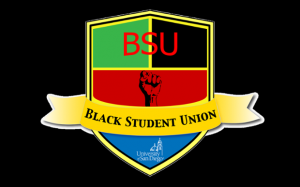Mingxing Li
Blog Post #2
May 7, 2019
The Black Student Union at the University of San Diego
Throughout the nation, every ethnically diverse college has a variety of organizations which support diversity in the community. Black Student Unions, a student organization supporting African American students, was developed across the nation in the late 1960s due to the rising number of black students at predominantly White colleges and universities (Williamson 2019, 92). During the time, the progressive spreading of the Black Power Movement had influenced the growth of the Black Student Union. The Black Student Union was founded in each university successively and kept influencing black student generations in multiple ways. In this essay, I will examine the origin of the Black Student Union and its impact on their communities such as spreading awareness, provide an outlet for African American expression, and inspire new generations of African Americans.
The Black Student Union at the University of San Diego was officially formed by Willam Miller on May 1, 1969.  As the Chairman of the first black student organization on campus, Willam, who once received discrimination because of his black identity, wanted to create a platform for this unique ethnic group to express their needs and advocate for solutions (Office of Public Information 1969, 195). First, Willam expected the establishment of the Black Student Union to inspire African American teenagers in high school to seek higher education. According to the news article, Jon Connor, who was the Minister of Information of BSU stated in details: “In the past black students wanted to be baseball players because of the black baseball stars. When I walked down the streets of South East San Diego, people know I am a college man. That may turn them off, but they know I am in college. Just being there is the best inspiration we can give black high school students.” Inspiring younger generations of African Americans was an essential reason for forming the Black Student Union. Supporting cultural programs and different dialogues on the university campus was another purpose of this student organization. The Black Student Union also demands to create a black studies department with multiple courses for all of the students on campus to understand the black culture in a systematic manner. According to the news article, a black literature course was successfully offered in the same calendar year as the founding of BSU. These mission statements the Black Student Union carry on had encouraged many African American students to call for equality in both academical field and social life.
As the Chairman of the first black student organization on campus, Willam, who once received discrimination because of his black identity, wanted to create a platform for this unique ethnic group to express their needs and advocate for solutions (Office of Public Information 1969, 195). First, Willam expected the establishment of the Black Student Union to inspire African American teenagers in high school to seek higher education. According to the news article, Jon Connor, who was the Minister of Information of BSU stated in details: “In the past black students wanted to be baseball players because of the black baseball stars. When I walked down the streets of South East San Diego, people know I am a college man. That may turn them off, but they know I am in college. Just being there is the best inspiration we can give black high school students.” Inspiring younger generations of African Americans was an essential reason for forming the Black Student Union. Supporting cultural programs and different dialogues on the university campus was another purpose of this student organization. The Black Student Union also demands to create a black studies department with multiple courses for all of the students on campus to understand the black culture in a systematic manner. According to the news article, a black literature course was successfully offered in the same calendar year as the founding of BSU. These mission statements the Black Student Union carry on had encouraged many African American students to call for equality in both academical field and social life.
From then on, the Black Student Union believed that creating several plans and devoting themselves to multiple projects could better serve their concentrations. One year from the formation of the Black Student Union, BSU hosted a dance event to raise funds for their dedicated projects. There were three main projects this student organization wanted to carry out, and they expected to raise money from the interesting events they held in order to allocate scholarships in the Educational Opportunity Program, community events, and speakers on campus (Office of Public Information 1970, 416). The Educational Opportunity Program provides several support services to assist, mentor, and advise students pursuing their academic career. As we all know, education always works as the most powerful weapon in the revolutionary movements. The equal educational opportunity was the major focus for African Americans during the time. In order to build a more diverse university community, community events were necessary to hold across the county for spreading awareness and gaining good reputations. Until now, propaganda is still a strong approach to receive political agreements in public. Having more speakers on campus could benefit not only young African Americans to gain consciousness but also students and staffs in other ethnic groups to better understand the black community. Therefore, the Black Student Union would have the ability to give a helping hand to black students in need by further accomplish these projects. After one year of BSU foundation, this ethnic group was creating more values toward their principles by holding inspiring events.
There were three main projects this student organization wanted to carry out, and they expected to raise money from the interesting events they held in order to allocate scholarships in the Educational Opportunity Program, community events, and speakers on campus (Office of Public Information 1970, 416). The Educational Opportunity Program provides several support services to assist, mentor, and advise students pursuing their academic career. As we all know, education always works as the most powerful weapon in the revolutionary movements. The equal educational opportunity was the major focus for African Americans during the time. In order to build a more diverse university community, community events were necessary to hold across the county for spreading awareness and gaining good reputations. Until now, propaganda is still a strong approach to receive political agreements in public. Having more speakers on campus could benefit not only young African Americans to gain consciousness but also students and staffs in other ethnic groups to better understand the black community. Therefore, the Black Student Union would have the ability to give a helping hand to black students in need by further accomplish these projects. After one year of BSU foundation, this ethnic group was creating more values toward their principles by holding inspiring events.
Like many other peers in the university community, I had opportunities to gain knowledge of black culture during the black history month. This year, the Black History Month was held by the school’s Black Student Resource Commons, including Black Student Union.  These major African American organizations hosted various celebrating events throughout February, such as films and art exhibitions. For this past black history month, we had at least four celebrating events occur on campus every week (USD News Center Staff 2019). Every event, from academics to sports, was created to illustrate the importance of understanding the history of African Americans. Back in 1970, the first black history celebration at USD was held during the last week of February. This celebration would not be held successfully without getting support from the Black Student Union. This first black history celebration is called “Black is Beautiful Week” and lasted for five days. Although it only had five days to celebrate instead of the whole month, the events occurred were very insightful. There were three speakers giving their speeches in public, a “Soul Food Dinner” served, a fashion show arranged, and an art exhibition offered for all students (Office of Public Information 1970, 368). More and more students started caring for black people and their particular concerns due to the celebration of black culture.
These major African American organizations hosted various celebrating events throughout February, such as films and art exhibitions. For this past black history month, we had at least four celebrating events occur on campus every week (USD News Center Staff 2019). Every event, from academics to sports, was created to illustrate the importance of understanding the history of African Americans. Back in 1970, the first black history celebration at USD was held during the last week of February. This celebration would not be held successfully without getting support from the Black Student Union. This first black history celebration is called “Black is Beautiful Week” and lasted for five days. Although it only had five days to celebrate instead of the whole month, the events occurred were very insightful. There were three speakers giving their speeches in public, a “Soul Food Dinner” served, a fashion show arranged, and an art exhibition offered for all students (Office of Public Information 1970, 368). More and more students started caring for black people and their particular concerns due to the celebration of black culture.
I believe the organization cannot be understood purely through the mission statement they post online, but it should be defined by their action. For example, the dance event the Black Student Union held was not only an event that gave more insights into African American culture through music but also a key event to raise funds to provide better educational opportunities. The purpose of the founding of the Black Student Union at the University of San Diego was to create a platform for African Americans students to express their special needs, spread their cultural values, and inspire younger generations. Besides, BSU also tried to bring black studies into the university course system. Since then, we as college students can learn the black culture systematically and better understand the black history in a proper way.
Bibliography
- Dizard, Jan E., and George Napper. “Blacker Than Thou: The Struggle for Campus Unity.” Contemporary Sociology5, no. 2 (1976): 187. doi:10.2307/2062980.
- Office of Public Information, “Black Students Union Formed at USD” (1969). News Releases. 195. https://digital.sandiego.edu/newsreleases/195
- Office of Public Information, “USD Students Note Black is Beautiful Week” (1970). News Releases. 368. http://digital.sandiego.edu/newsreleases/368
- Office of Public Information, “Black Students Union Dance to Raise Funds for Scholarships” (1970). News Releases. 416. http://digital.sandiego.edu/newsreleases/416
- USD News Center Staff. “USD Celebrates Black History Month.” USD Celebrates Black History Month – University of San Diego. February 21, 2019. https://www.sandiego.edu/news/detail.php?_focus=70770.
- Williamson, Joy Ann. “In Defense of Themselves: The Black Student Struggle for Success and Recognition at Predominantly White Colleges and Universities.” The Journal of Negro Education68, no. 1 (1999): 92. doi:10.2307/2668212. https://www.jstor.org/stable/2668212?seq=7#metadata_info_tab_contents

